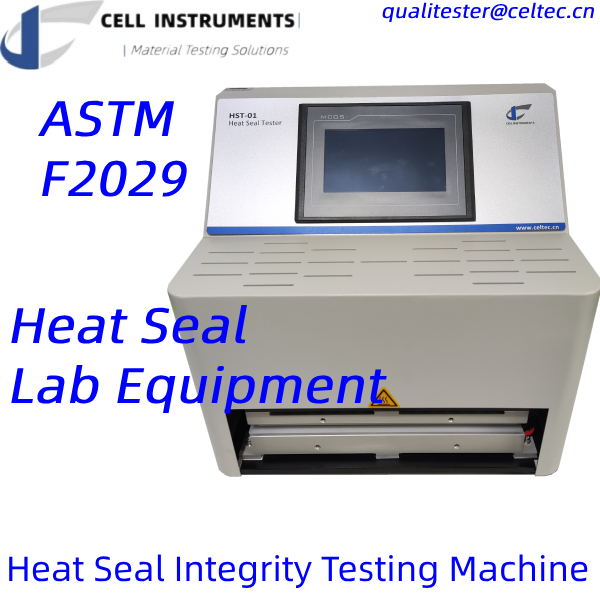Introduction
Heat seal strength is a critical parameter in ensuring the integrity and reliability of packaging, medical devices, and various other products. Understanding the science behind heat seal strength and utilizing the right testing equipment is essential for manufacturers striving to meet industry standards, especially those outlined in ASTM F2029.
Why Heat Seal Strength Matters
The strength of a heat seal determines the durability and safety of a product’s packaging. In industries like food, pharmaceuticals, and medical devices, the quality of heat seals directly impacts product shelf life, safety, and compliance with regulations. Weak or inconsistent seals can lead to contamination, product degradation, or even regulatory non-compliance, making heat seal strength testing a non-negotiable step in the quality assurance process.
Key Factors Influencing Heat Seal Strength
Several factors contribute to the strength of a heat seal, including temperature, pressure, and dwell time. The material composition and thickness also play a crucial role. The challenge lies in optimizing these variables to achieve a seal that is both strong and uniform. This is where ASTM F2029 comes into play, providing a standardized method for creating and evaluating heat seals, ensuring consistency across different materials and applications.
Heat Seal Strength Testing: Procedures and Equipment
To accurately measure heat seal strength, it is essential to follow standardized procedures and use reliable lab equipment. ASTM F2029 outlines the steps for preparing, sealing, and testing materials:
- Preparation of Test Specimens: Samples should be cut to specified dimensions, ensuring uniformity and cleanliness.
- Setting Test Parameters: Appropriate temperature, pressure, and dwell time must be selected based on the material being tested.
- Conducting the Test: Samples are placed between heated sealing bars, where pressure and heat are applied according to pre-set parameters.
- Measuring Seal Strength: After sealing, a tensile testing machine is used to measure the force required to break the seal.
The Heat Seal Tester from Cell Instruments is a prime example of a reliable lab device that meets these requirements. Designed with precision and compliance with ASTM F2029, this equipment ensures that all heat seal tests are conducted under consistent and repeatable conditions.
Applications of Heat Seal Strength Testing
Heat seal strength testing is crucial across various industries:
- Packaging: Ensures that seals on food and beverage packaging maintain product freshness and safety.
- Medical Devices: Verifies the integrity of sterile packaging to prevent contamination.
- Pharmaceuticals: Tests blister packs and other packaging to ensure compliance with regulatory standards.
- Textiles: Evaluates the durability of heat-sealable fabrics.
- Adhesives: Ensures strong and durable bonds in different applications.
The Role of ASTM F2029 in Ensuring Quality
ASTM F2029 sets the standard for making and evaluating heat seals. By adhering to these guidelines, manufacturers can guarantee that their products meet global quality and safety standards. This not only improves product reliability but also boosts consumer confidence and brand reputation.
Conclusion
Mastering heat seal strength testing is essential for any manufacturer involved in packaging, medical devices, textiles, and related industries. By using ASTM F2029-compliant equipment like the Heat Seal Tester from Cell Instruments, companies can ensure that their products meet the highest standards of quality and safety.
FAQ
- What is heat seal strength?
- Heat seal strength measures the force required to separate a sealed material, ensuring the seal’s reliability and durability in packaging and other applications.
- Why is ASTM F2029 important in heat seal testing?
- ASTM F2029 provides standardized procedures for making and testing heat seals, ensuring consistency and reliability across different materials and industries.
- What factors influence heat seal strength?
- Temperature, pressure, dwell time, and material composition are key factors that affect the strength of a heat seal.
- How can I ensure my heat seals meet industry standards?
- Using ASTM F2029-compliant equipment like the Heat Seal Tester from Cell Instruments ensures that your seals meet required standards for strength and uniformity.
- What industries benefit most from heat seal strength testing?
- Packaging, medical devices, pharmaceuticals, textiles, and adhesives are among the industries that rely heavily on accurate heat seal strength testing for product quality assurance.
Related Products
Related Article
Heat Seal Strength Test Method
Polyethylene Heat Seal Temperature
Seal Strength of Plastic Films
Heat Seal Equipment for Laboratory Testing
Laboratory Heat Sealer for Film Testing
Plastic Film Heat Seal Testing


